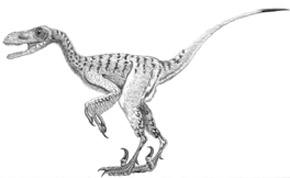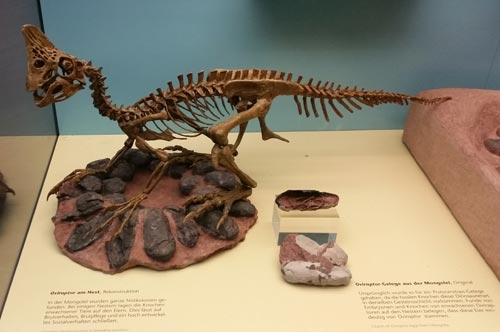Nesting Dinosaurs – More Evidence from North America
Imagine the scene, it is late in the Cretaceous and a small theropod dinosaur has a difficult decision to make, should it stay, guarding its nest on the banks of a rapidly rising river or make a run for it before the fast rising waters engulf both it and its brood It’s a tough decision for brooding meat-eating dinosaurs.
That is the scenario imagined by a team of Canadian researchers as they study a unique fossilised dinosaur nest dating from the Campanian faunal stage (dated to approximately 77 million years ago), found in the Medicine Hat Formation of Montana. The research team have used this fossil dinosaur nest to learn more about how these ancient reptiles constructed nests and brooded eggs.
Brooding Meat-eating Dinosaurs
However, working out what type of dinosaur was responsible for the nest was quite a challenge, the team’s efforts to study this unique find and identify the culprit are written up in the scientific journal Palaeontology.
“Working out who the culprit was in this egg abandonment tragedy is a difficult problem to crack,” commented Darla Zelenitsky, University of Calgary palaeontologist and co-author of a paper, in a statement, part of a Calgary press release. Dr Zelenitsky, an Associate Professor of the Deparment of Geoscience at Calgary University has worked on a number of North American dinosaur eggshell discoveries, particularly egg fragments discovered in the Oldman Formation (Judith River Group – Alberta), which also date from the Campanian faunal stage.
“After further investigation, we discovered that this find is rarer than we first thought. It is a one of a kind fossil. In fact, it is the first nest of its kind in the world.”
It is often difficult to relate the fossil material to a particular dinosaur family (taxonomic reference). In this case, the specimen of a fossil nest was part of a private collection and had been labelled as belonging to a Hadrosaur (duck-billed dinosaur). Such misidentification is unstandable, as in the absence of any fossil bones either from brooding adults or embryos still inside the unhatched eggs or the fossil remains of baby dinosaurs, it is difficult to work out what type of dinosaur laid the eggs.
Dinosaur Eggshell Fragments
However, by analysing the eggshell fragments, the team were able to identify that this was the nest of a small meat-eating dinosaur and not from a plant-eating ornithopod.
“Nests of small theropods are rare in North America and only those of the dinosaur Troodon have been identified previously,” added Dr Zelenitsky.
“Based on characteristics of the eggs and nest, we know that the nest belonged to either a caenagnathid or a small raptor, both small meat-eating dinosaurs closely related to birds. Either way, it is the first nest known for these small dinosaurs.”
Raptors, more appropriately termed dromaeosaurids, were small, agile, hunters of the Late Cretaceous, a typical dromaeosaur would be Saurornitholestes (the name means “lizard bird thief”), a swift predator that reached lengths in excess of two metres. A number of dromaeosaurid fossils are known from Montana, animals such as the fearsome Deinonychus and the smaller, meat-eater called Bambiraptor – a dinosaur named after the deer in the Disney film.
An Illustration of a Typical Dromaeosaurid

Picture credit: Mike Fredericks/Everything Dinosaur
The picture above shows a typical dromaeosaur, covered with proto-feathers, grasping hands and the three-toed claws with the single retractable claw on each foot.
“Our research tells us a lot about the dinosaur that laid the eggs and how it built its nest,” commented Francois Therrien, another member of the scientific team and curator of Dinosaur Palaeoecology at the Royal Tyrrell Museum in Drumheller (Alberta).
Dinosaur Fossil Nests
The fossil nest is a mound of sandstone, approximately 50 cm in diameter. The eggs were laid in pairs on the sloping sides of the mound to form a ring of eggs. The flattened top of the mound was where the adult dinosaur sat to brood the clutch. Whether, this was the duty of just one of the breeding pair is unknown, perhaps the female brooded the eggs whilst her mate brought food to the nest, or perhaps these little dinosaurs worked in shifts to protect the eggs and keep them warm. Unfortunately, evidence of behaviour such as this is not preserved in the known fossil record.
A Theropod Dinosaur Nest (Oviraptor)
Picture credit: Everything Dinosaur
By studying the fossil the scientists have been able to determine that this dinosaur dug its nest in freshly deposited, loose sand, possibly along the shore of a river. An analysis of the substrate under the actual fossil indicates that the dinosaur disrupted the rock underneath, indicating that there was a substantial amount of effort put into the digging when excavating the nest. Perhaps this indicates that the mated pair worked together or that both the front claws and the strong hind limbs were used to construct the nesting mound.
Approximately, a dozen asymmetrical, slightly elongated eggs were laid in pairs against the sides of the mound. The raised central area was flat, a comfortable place for the dinosaur to crouch down to brood the clutch. These type of feature can be clearly seen in the fossilised nest of a dromaeosaur shown in many pictures.
The Montana specimen may also represent the nest of a Caenagnathidae dinosaur, a type of dinosaur closely related to the bird-like oviraptorids. The word caenagnathid means “recent jaws”. When these Cretaceous animals were first researched, it was noted that the lower jaws possessed several features that resembled the jaws of ostriches and other modern flightless birds. It was due to this resemblence that these animals were called caenagnathids.
Using high powered microscopes the detail on the outer surface of the eggshells was revealed. The eggs had a ridge-like pattern on them. The fact that the eggs were laid in pairs is significant. This indicates that these dinosaurs had two oviducts (the tubes through which the eggs pass through whilst being laid). Modern birds have only one oviduct. Scientists believe that birds lost the second oviduct as this helped them become lighter which was an aid to flight. The changes in the Aves reproduction processes occurred to prevent them having to fly around with a body full of eggs, this is why a bird may take several days to lay its clutch with one egg being laid at a time.
The evidence from these fossil theropod nests indicate that they laid eggs in pairs, laying from both oviducts at the same time and their exact placement in the nest may show that the mother pushed the eggs down into the sand to secure them in place. As far as we know from the fossil record no other animal has ever laid eggs in this manner; laying eggs out of both oviducts at the same time. It is also likely that the eggs were laid in one big clutch with no long interval between laying. This can be assumed as it would have been difficult for a dinosaur, even one as nimble as a small theropod to return to egg laying, say after laying half her batch.
It would be quite tricky to keep glancing around your legs to make sure that you were laying the next pair of eggs in the right position relative to the previous pair laid. Best thing to do would be to try to complete the egg laying in one rhythmic sequence, after all, crocodiles lay all their eggs at once.
Finding evidence of two oviducts in theropod dinosaurs is significant, particularly if the nest is suspected of having been made by a dromaeosaur. This has implications for a theory put forward by the American palaeontologist Greg Paul. In his book “Dinosaurs of the Air”, published in 2002, Paul puts forward the theory that dromaeosaurs such as Velociraptor and Deinonychus are descended from flying ancestors. He speculates that the ancestor of these agile, carnivores would have been an animal with the capability of flight but with teeth and claws – something like an Archaeopteryx (Late Jurassic).
At some time between the end of the Jurassic and the Late Cretaceous the descendants of these birds would have lost their power of flight and taken to a ground dwelling existence. The wings would have gradually become smaller over many generations and the powerful chest muscles required for flight would have been reduced. The jaws, teeth and the long tail would have been retained, the tail acting as a balancing device rather than a rudder and stabiliser in powered flight. These dromaeosaurs would have retained feathers as insulation and their warm-blooded metabolism, like flightless birds today such as emus and rheas. These animals would have gradually become heavier, until the only connections between them and their flying ancestors were subtle similarities in the skeleton.
However, the fact this fossil nest shows evidence of two oviducts in the animal that laid the eggs, challenges this particular theory. If a dromaeosaur had built this nest then how could an animal such as this have two oviducts, whilst in Paul’s thesis the creatures that it is supposed to be descended from were on their way to having only one? Unless of course primitive birds did not lose the ability to lay eggs in pairs until much later in their evolution, or this fossilised nest from Montana is not evidence of dromaeosaur activity but caenagnathid instead.
Such fossils as the one studied by the Canadian team, help provide fresh insight into dinosaur behaviour and their anatomy, but they also open up lots and lots of new intriguing questions.
As part of our many dinosaur themed activities the team at Everything Dinosaur published a dinosaur chocolate nest recipe, a fun recipe idea for young palaeontologists to make their own dinosaur nests – and get to eat them as well. They are easy to make (we have all had a go) and great for parties or just an occasional treat.
Our Dinosaur Chocolate Eggs

Picture credit: Everything Dinosaur
Notice how the mini eggs have been placed in our little dinosaur nests, they have been laid in pairs, just like the eggs laid in the fossil studied by the Canadian palaeontologists.
To view the many dinosaur and prehistoric animal themed gifts and toys available from Everything Dinosaur, visit the company’s website: Everything Dinosaur.







This blog post is my favorite 1 so far: I'm most interested in how dinos in general & dromaeosaurids in particular lived & evolved. However, I've been wondering about the following blog post quotes. Many thanks in advance for your help.
“By studying the fossil the scientists have been able to determine that this dinosaur dug its nest in freshly deposited, loose sand, possibly along the shore of a river. An analysis of the substrate under the actual fossil indicates that the dinosaur disrupted the rock underneath, indicating that there was a substantial amount of effort put into the digging when excavating the nest. Perhaps this indicates that the mated pair worked together or that both the front claws and the strong hind limbs were used to construct the nesting mound.”
Since we know “the forelimbs could not be used to dig” ( http://www.tandfonline.com/doi/abs/10.1671/0272-4634%282006%2926%5B897%3ACOFFBD%5D2.0.CO%3B2 ), is it safe to say that the mated pair probably worked together? I figured so, but I wanted to make sure.
“An Example of a Theropod Nest (Dromaeosaur)”
Is it really a dromaeosaurid nest (&, if so, what paper is it described in?) or is it just mislabeled? I ask b/c the only confirmed dromaeosaurid nest I've heard of is the 1 described in Grellet-Tinner and Makovicky, 2006 ( http://www.nrcresearchpress.com/doi/abs/10.1139/e06-033 ).
I just wanted to make sure the questions in my 1st response (I was Anonymous) weren’t forgotten about. Again, many thanks in advance for your help.